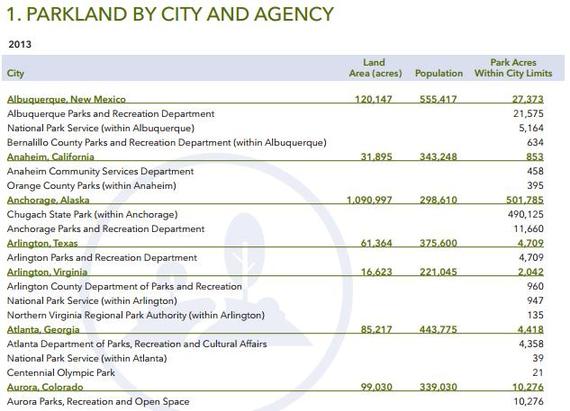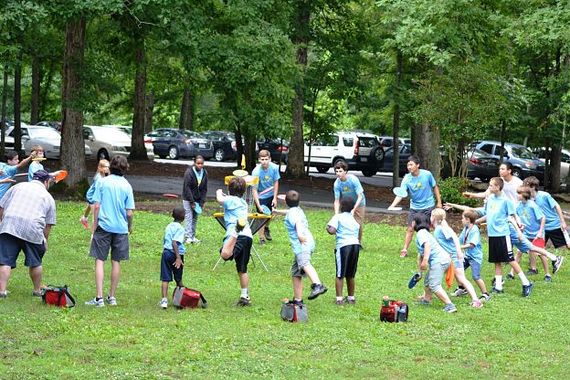Arlington, VA, is going to the dogs and to the seniors who like to stay in shape. Chula Vista, CA, is "sick" when it comes to skate parks. And the most heavily visited park in America is an old freight rail line.
In a more serious vein, spending on city parks tends to be highest in coastal cities and "blue states," and as a result, those cities may have better park systems than "red state" cities.
These and other facts -- both surprising data and complex analyses -- can be mined from the 2014 City Park Facts (CPF), just published by The Trust for Public Land's Center for City Park Excellence (CCPE).
City Park Facts is a compendium of facts and analysis of the nation's 100 largest cities compiled by the CCPE, which also uses the data to put together "ParkScore,"a ranking of the 50 largest cities (to expand to 60 this year) in terms of how well they provide parks for their residents.
Among the factors CPF examines is the size of the park systems, what percent of the city is dedicated to parks, the amount of parkland and number of playgrounds per capita, spending on parks, and how many residents live within a 10-minute walk of a park. In fact, it's all about numbers, according to Peter Harnik, Director of the CCPE: "If you don't count, you don't count. We think city parks really do count towards urban excellence, and we're committed to documenting all their attributes and variety." Harnik compares the process of creating CPF to human gestation: about nine months of work, including detailed contact with 240 separate municipal, county, state, and federal park agencies to gather the facts.
The first category, an alphabetical listing of cities with total parkland acreage, shows that many of the largest park systems are in the South and Southwest (though by far the largest city park system is in Anchorage, Alaska, with more than 500,000 acres, most of which is a state park within the city limits). Among the 20 cities with more than 20,000 acres of park land, five are in Texas, five more are elsewhere in the Southwest, and eight more are south of the Mason-Dixon line. Several of those cities have very large, mostly undeveloped natural areas.
"The idiosyncrasies of municipal boundaries can pull in large preserves and wetlands," says Abby Martin, CCPE Research Coordinator, "as in Scottsdale's McDowell Sonoran Preserve, Chesapeake's Great Dismal Swamp National Wildlife Refuge (NWR), or New Orleans's Bayou Sauvage NWR. Scottsdale is an interesting story, as they recently expanded the McDowell Sonoran Preserve, giving them 1,000 acres of 'typical' designed parkland and another 28,000 of municipal mountain parkland."
Following that line of thought, the CPF also shows the balance between developed parkland and natural areas in all the cities. Hialeah, Fla. and Newark, N.J. are cities whose park systems are 100 percent "designed," and managed for active use by people. Most cities have a mix, such as Arlington, Texas, which has an almost exact 50-50 blend of manicured and natural parks. On the other end, Anchorage's park system is almost all natural.
But when it comes to how many people live within walking distance of a park or playground, and spending on parks in cities, those trends reverse quite dramatically. Among the 20 cities with the largest park systems, only New York City and Albuquerque are also in the top 20 cities for the percent of the population who have easy walking access to a park (NYC is number 3, with 96.4 percent of its population living within a 10-minute walk of a park or playground, and Albuquerque is 12th, with 81 percent).
As for spending on parks, again, size doesn't really matter. Washington D.C., with just over 8,000 acres of parkland, spends a whopping $287 per resident, though those figures are augmented by the amount of money the National Park Service spends on the tourist-heavy destinations, including the Mall and all the monuments. The list of top 20 cities for per capita spending includes only two with the largest park systems: NYC at no. 11, spending $189 per resident, and Scottsdale at no. 17, spending $147 per resident. (The CPF report does not track private, philanthropic spending on parks--if it did, NYC would probably come in much higher on spending, given the $165 million or so that private non-profit organizations raise and spend annually on city parks).
The new edition of CPF also contains a novel way of interpreting how cities allocate funding for parks: in addition to tracking the dollars spent per resident, it also looks at those same figures adjusted for the price of living. With that more nuanced look, Arlington, VA, second on the first list, drops to 6th when its spending is adjusted for the cost of living, and Cincinnati moves up from 12th to 5th.
The report also has a wealth of interesting detail on trends and recreational interests. For example, Arlington, Va, dominates the 10 "Snapshots," and is featured in seven of them, coming out on top in such categories as most off-leash dog parks (7.2 per 100,000 residents), most recreation and senior centers, (3.1 per 20,000 residents), most tennis courts (8.1 per 10,000 residents) and most nature centers (2.3 per 100,000 residents). In fact, Arlington performs well across all of the standard measures of park excellence. "Great parks and community spaces are an integral part of what makes Arlington a dynamic place to live, work, and visit," says Jane Rudolph, director of the Arlington County Department of Parks and Recreation. "Our elected officials and County leadership 'get' that well maintained parks and access to an array of amenities help to build a healthy, livable community."

James Hunter Dog Park in Arlington, VA. Image Courtesy of Arlington County Department of Parks and Recreation.
Other cities also found space to shine in the snapshots. If you love baseball and softball, forget Cooperstown, N.Y. and go to the Twin Cities. St. Paul and Minneapolis go 1-2 in Most Ball Diamonds per 10,000 residents. When it comes to beaches per 100,000 residents, the Midwestern cities of Madison, Wis. and Minneapolis take the lead. Another new trend? Disc Golf courses, where Charlotte, NC has the highest total at 10, and another NC city, Durham, has the most per capita.
Not surprisingly, densely populated and tourist-heavy New York City owns the "Most Visited City Parks per Acre" category, taking five of the top 10 spots, including the top two spots. With more than 650,000 annual visitors per acre, The High Line, formerly an abandoned elevated freight train line, is the most visited park in the nation, followed by midtown Manhattan's Bryant Park, once a forbidding drug den and now a bustling hub of activity, thanks to the then-novel use of a business improvement district to restore and manage the park.
American history enthusiasts will enjoy perusing City Parks Facts' list of the 50 oldest parks. While it reads like an account of colonial and industrial revolution development patterns, there are even some surprises. Predictably, the 10 oldest parks are found mainly in cities in the original 13 colonies, whose small village greens emulated models in England. But 3 of the 10 oldest parks can be found in New Orleans, San Antonio, and Albuquerque--evidence of other colonial influences. So whether you are a parks aficionado or a trivia buff, a deep diver into geography or statistics, a municipal official or an open space advocate, 2014 City Parks Facts is a fun and interesting read as well as an important resource.


